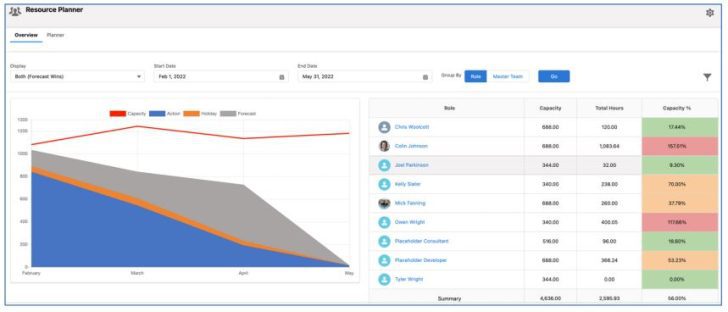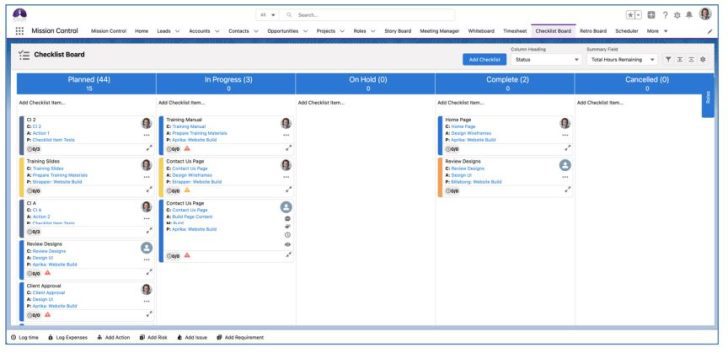
Enterprise Times had the opportunity to talk to Colin Johnson, CEO and co-founder of Aprika, the vendor behind Mission Control, about the latest release. Why did you focus on Resource Forecasting for this release?

“It’s been on the roadmap for some time. The resource forecasting module is a huge piece of work. We’re addressing a number of different requirements within this feature. We’ve taken some time to consult various customers. We wanted to make sure we were capturing as many customer requirements as possible.”
The update comes after a successful year for Aprika, as Johnson explained: “We’ve had 50% growth over the last 12 months. At the financial year-end, which in Australia is in June, we’re expecting to be over 10,000 users by that point. We’re 12 (Employees) now. By the start of the next financial year, we’ll be looking to be 15 and fully expect to be 20 within the next six to 12 months.”
Resource Forecasting
Like all other Mission Control features, Resource Forecasting is included within the standard Mission Control suite. Customers can switch it on if they wish to. Johnson believes that it offers some customers the level of granularity they seek, while others may not choose to use. The new feature has three main components:
Role Forecasting
This feature enables project managers to soft book resources within a Salesforce opportunity. Opportunities within professional services naturally require resources. While nothing is signed yet, it is still valid and useful to understand what type of person is required to fulfil the requirement and for how long they are required. Against each opportunity, it is possible to create these placeholders; Mission Control defines them as Role Forecasts.
When creating a role forecast within an opportunity, the user can select a specific individual or can create a general role such as a developer. They can further define role requirements by selecting one or more skills, such as Java, C# etc. Once the role is selected, the user can add the estimated billable and non-billable hours required for this opportunity. They can then enter the start date, and the system will pick up the hourly rate, hourly costs and calculate the finish date.
Once the role forecasts are entered, a user can visualise the impact of resource forecasts on the organisation with interactive charts showing the data and the capacity overview. It shows allocated resources, booked holidays, forecast and maximum capacity over three months. This period can be varied, so some firms may wish to look only a month out, others a year.

The planner tab shows a forecast of utilisation in the future, by day, weeks, or months. It highlights where individuals are over or underutilised.
Role Availability Management
This object enables users to create the time available for each role within the organisation. It is this information that the role forecast maps against for the opportunity. Where known it is possible to allocate holiday hours to the role, either as a block of days or as a certain amount of daily hours.
Hours Distributor
This is a comprehensive set of rules that apply when project dates are shifted, the project intensity changes or a new role is added to the opportunity. It means that the user can opt to use the automated rule, which reallocates time evenly. Or, they can complete it manually and choose how to allocation time to each role.
Other features
The other features that Mission Control ads with this release include:
Checklist Kanban
There is a new Kanban board for Checklist items. This is a visually interactive way for users to work with checklists. It enables them to quickly update items between: planned, in progress, on hold, complete and cancelled. Each post-it note on the board relates to a specific checklist item and can contain the name, the project, start and end date and item owner. Users can quickly add and configure checklist post-its and can vary the views on the Kanban, sorting posts-its using various criteria. It is also possible to filter checklists so that checklists can be viewed for a specific action, project or individual.

Billing Event Generator
It is now possible to apply a billing type to a milestone. This means that a milestone for a specific stage could be set as a fixed price or fixed price + expenses. Alternatively, a monthly milestone might be based on time and materials. When a milestone is reached, the system can automatically create a billing event, automating a time-consuming process for users.
Status Path Component
A read-only view displays the progress for a given project, milestone, or action. The visualisation is a lightning web component that displays details using a colour code to identify how each component is progressing.
Auto-Generation Enhancements
Mission Control allows users to generate projects from opportunities automatically. This enables projects to be prepopulated with actions and checklists based on existing products templates.
The latest improvements will save even more time for project managers once templates are created. A user can now associate specific milestones to each product. For example, a webpage product might have four milestones: design, build, content and testing. These milestones are automatically added as a project is generated for a client.
The generation method now supports a product quantity. Thus if five web pages were required, Mission Control would create 5×4=20 milestones and the associated actions and checklists.
Checklist
Several improvements to checklists were added. These can now be allocated even if they have zero hours attached. Baseline dates are now available for checklist items. These behave in the same way as those for project, milestone, and action objects.
There is now the flexibility to support both rolled up hours for checklist items into actions and the ability not to roll them up. This feature was added as customers worked in both ways.
Others
Mission control 1.60 contained several other new improvements, areas impacted include:
- Time Logs include the ability to stop unassigned roles logging time
- Create Actions Page including support for 5 customer fields
- Gantt Chart Enhancements include a feature to collapse and expand actions and milestone
- Project Overview & Read-Only Page allow greater visibility in what is displayed and how it is displayed
- When a holiday is booked, the start and end dates of actions allocated to the role are automatically adjusted
- The project and milestone clone feature now supports the ability to select which fields are visible in the Project/Milestone field sections of the page.
What’s missing?
What was missing was any update of the retrospective functionality launched in the previous release. ET asked Johnson about this.
He replied: “There are no enhancements to it, it’s been well-received, and we’ve hadn’t had any feature requests. Funnily enough, I literally had a conversation with one of our customers in the US today about it. A very minor feature request that’s going to be coming later this year is the custom fields that you add to the object are visible on the retro cards.”
One area Johnson spoke about last year was the integration to Slack following the acquisition by Salesforce. ET asked Johnson about the status of that.
“There is a Slack integration available on the App Exchange. We’ve been evaluating that in the last year and don’t feel that the off the shelf AppExchange solution for Slack support of custom objects is what we’re looking to deliver. We now have got a Slack integration on our roadmap.”
Johnson clarified that this is likely to be at the end of 2022 or the beginning of 2023.
When is this happening?
Aprika has a set timeline for the update. Customers should review and check the full release notes, including details of the install process.
- 18th February 2022 – Available for manual upgrade from the AppExchange
- 26th February 2022 – Automatic upgrade to all Sandbox Orgs
- 5th March 2022 – Automatic upgrade to all Production Orgs
Looking forward
What is on the road map for 2022?
“One of the things that I’m most excited about is what we’re calling an Order Assignment wizard. You’re going to be able to automatically assign the most appropriate resources to a project based on a variety of weighted factors. Factors like skillset and their proficiency at those skills, their availability during that period, and so on.”
Are you adding anything about employee preferences?
“Yes, we are. Something else on the roadmap is evolving the existing skills matrix functionality to where it becomes a place where they can document their professional development. So things that they’re good at, but they might not necessarily enjoy. Things they want to become better at and setting targets around how they’re going to achieve that improvement. Along with a peer review of those skills as well.
“I’m also excited about our programme planner. We’re looking to add in a feature that allows teams to estimate the effort of user stories. Rather than just capturing a consolidated effort, the idea being that a group of people can each review that and come together. You might think that the effort is 10 hours, I might think it’s 8 hours and James 15 hours. We were ultimately able to agree on a consensus and capture all those estimates.”
Enterprise Times: What does this mean
This is a feature-rich update for Mission Control from Aprika. Resource forecasting is a powerful tool, though it may be questioned about its scalability. Users currently have to enter the resource requirements into an opportunity manually. Could Mission Control automate this for existing products in the future and automatically suggest resource allocations?
While this approach certainly works for more ad hoc and smaller operations, for larger organisations with multiple repeating engagements, there could be a challenge without further development. However, this module is in beta, so it will be interesting to see which direction customer demand drives it.
Mission Control continues to grow steadily. It is still a small organisation. It will reach the crisis point when it hits around 50 employees, and the organisational structure often changes at this point. The team is currently split between the US and Australia, and it will be interesting to see how its organic growth continues.
With consolidation in the market, could it also become a target for a VC or other player looking to add another PSA solution, one with a focus on (though not exclusively) the software market?

























